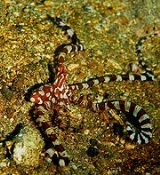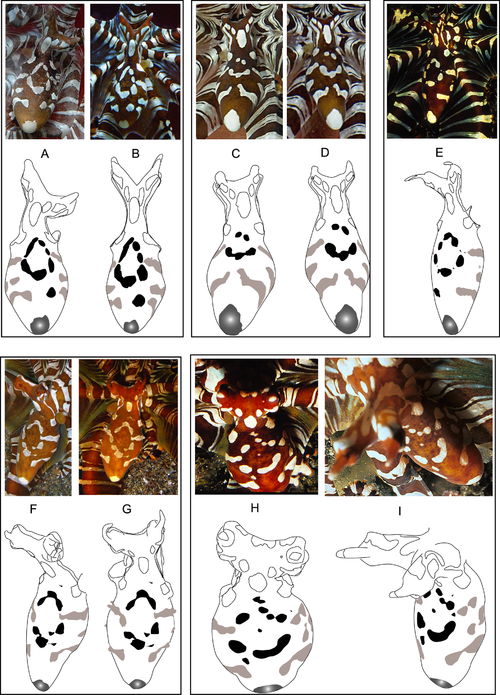
Wunderpus photogenicus
Encyclopedia
The wonderpus octopus is a species of octopus
in the monotypic
genus
Wunderpus. It is found in shallow waters from Bali
and Sulawesi
north to the Philippines
and east to Vanuatu
. W. photogenicus is a long-armed species characterised by "small eyes on elongate stalks, a long, conical papilla over each eye and a dramatic and fixed colour pattern of white bars and spots over a brown-red background."

, Thaumoctopus mimicus. Both T. mimicus and W. photogenicus can have variable activity patterns, however T. mimicus is most often diurnal, while Wunderpus tends to emerge very slowly from dens in the sand at dusk and dawn and is a crepuscular
hunter.
Wunderpus photogenicus has well-defined white spots on the mantle, and bars on the arms. They lack a white border at the base of the suckers. These are some of the traits that distinguish it from T. mimicus, which has poorly-defined dark and white markings on the mantle, and a bright white line along the base of the suckers.
The white spots of Wunderpus are unique among individuals, allowing for the use of photo identification to monitor individuals in the wild.
Wunderpus hatchlings can be identified by their unique 'founder chromatophore
' patterns.

Octopus
The octopus is a cephalopod mollusc of the order Octopoda. Octopuses have two eyes and four pairs of arms, and like other cephalopods they are bilaterally symmetric. An octopus has a hard beak, with its mouth at the center point of the arms...
in the monotypic
Monotypic
In biology, a monotypic taxon is a taxonomic group with only one biological type. The term's usage differs slightly between botany and zoology. The term monotypic has a separate use in conservation biology, monotypic habitat, regarding species habitat conversion eliminating biodiversity and...
genus
Genus
In biology, a genus is a low-level taxonomic rank used in the biological classification of living and fossil organisms, which is an example of definition by genus and differentia...
Wunderpus. It is found in shallow waters from Bali
Bali
Bali is an Indonesian island located in the westernmost end of the Lesser Sunda Islands, lying between Java to the west and Lombok to the east...
and Sulawesi
Sulawesi
Sulawesi is one of the four larger Sunda Islands of Indonesia and is situated between Borneo and the Maluku Islands. In Indonesia, only Sumatra, Borneo, and Papua are larger in territory, and only Java and Sumatra have larger Indonesian populations.- Etymology :The Portuguese were the first to...
north to the Philippines
Philippines
The Philippines , officially known as the Republic of the Philippines , is a country in Southeast Asia in the western Pacific Ocean. To its north across the Luzon Strait lies Taiwan. West across the South China Sea sits Vietnam...
and east to Vanuatu
Vanuatu
Vanuatu , officially the Republic of Vanuatu , is an island nation located in the South Pacific Ocean. The archipelago, which is of volcanic origin, is some east of northern Australia, northeast of New Caledonia, west of Fiji, and southeast of the Solomon Islands, near New Guinea.Vanuatu was...
. W. photogenicus is a long-armed species characterised by "small eyes on elongate stalks, a long, conical papilla over each eye and a dramatic and fixed colour pattern of white bars and spots over a brown-red background."

Identification
W. photogenicus is often confused with the similarly coloured Mimic OctopusMimic Octopus
The Mimic Octopus, Thaumoctopus mimicus, is a species of octopus that has a strong ability to mimic other creatures. It grows up to 60 cm in length. Its normal colouring consists of brown and white stripes or spots....
, Thaumoctopus mimicus. Both T. mimicus and W. photogenicus can have variable activity patterns, however T. mimicus is most often diurnal, while Wunderpus tends to emerge very slowly from dens in the sand at dusk and dawn and is a crepuscular
Crepuscular
Crepuscular animals are those that are active primarily during twilight, that is during dawn and dusk. The word is derived from the Latin word crepusculum, meaning "twilight." Crepuscular is, thus, in contrast with diurnal and nocturnal behavior. Crepuscular animals may also be active on a bright...
hunter.
Wunderpus photogenicus has well-defined white spots on the mantle, and bars on the arms. They lack a white border at the base of the suckers. These are some of the traits that distinguish it from T. mimicus, which has poorly-defined dark and white markings on the mantle, and a bright white line along the base of the suckers.
The white spots of Wunderpus are unique among individuals, allowing for the use of photo identification to monitor individuals in the wild.
Wunderpus hatchlings can be identified by their unique 'founder chromatophore
Chromatophore
Chromatophores are pigment-containing and light-reflecting cells found in amphibians, fish, reptiles, crustaceans, and cephalopods. They are largely responsible for generating skin and eye colour in cold-blooded animals and are generated in the neural crest during embryonic development...
' patterns.


